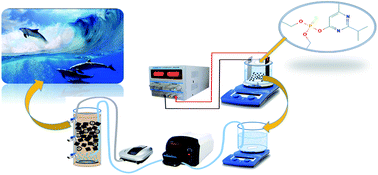Moving-bed biofilm reactor combined with three-dimensional electrochemical pretreatment (MBBR–3DE) for 2,4-D herbicide treatment: application for real wastewater, improvement of biodegradability†
Abstract
2,4-Dichlorophenoxyacetic acid (2,4-D) is a herbicide that is considered as a carcinogenic and highly toxic contaminant, and due to its biological and chemical stability, its degradation is very difficult. Therefore, this study aimed to investigate a hybrid system's efficiency of three-dimensional electrochemical (3DE) process and a moving bed biofilm reactor (MBBR) in removing 2,4-D herbicides from aqueous solutions. In this experimental study, the electrochemical degradation of 2,4-D herbicide in a 3DE process with a G/β-PbO2 anode was first investigated as a pretreatment process. Then, in the post-treatment stage, MBBR with continuous flow was used. The amount of aeration in the MBBR reactor was 4 L min−1, and the amount of dissolved oxygen (DO) was in the range of 3–5 mg L−1. The effect of various parameters such as hydraulic retention time (HRT) and filling ratio were investigated. The amount of sewage injection was set between 0.001–0.004 L min−1. Routine microbiological biochemical tests were used to detect bacteria. BOD5/COD, COD/TOC, AOS, and COS ratio parameters were used to determine the biodegradability of 2.4-D due to the effluent of the 3DE process. The results showed that with increasing current density, decreasing pH, decreasing herbicide concentration and increasing electrolysis time, the herbicide degradation efficiency increased by 3DE pretreatment process. Based on the results of MBBR post-treatment process efficiency, with increasing HRT and filling ratio, the herbicide removal efficiency increased. According to the results, the highest removal efficiencies of 2,4-D and COD herbicides were obtained during HRT of 24 h, and the filling ratio of 70% were 97.33% and 88.95%, respectively. The consortium of 2,4-D degrading bacteria identified in this study included E. coli, Enterobacter spp., Bacillus spp., Alcaligenes spp., Proteus spp., Acinetobacter spp., Pseudomonas spp., Arthrobacter, and Brevundimonas vesicularis. In the MBBR biological process, the reaction kinetics followed the Grau second-order model (R2 = 0.98). In general, the results showed that the combined process of 3DE with G/β-PbO2 anode and MBBR biological process has relatively high efficiency in 2,4-D herbicide degradation and can be used as a suitable complementary treatment method in wastewater containing non-degradable compounds such as phenoxy herbicides, e.g., 2,4-D should be used.



 Please wait while we load your content...
Please wait while we load your content...